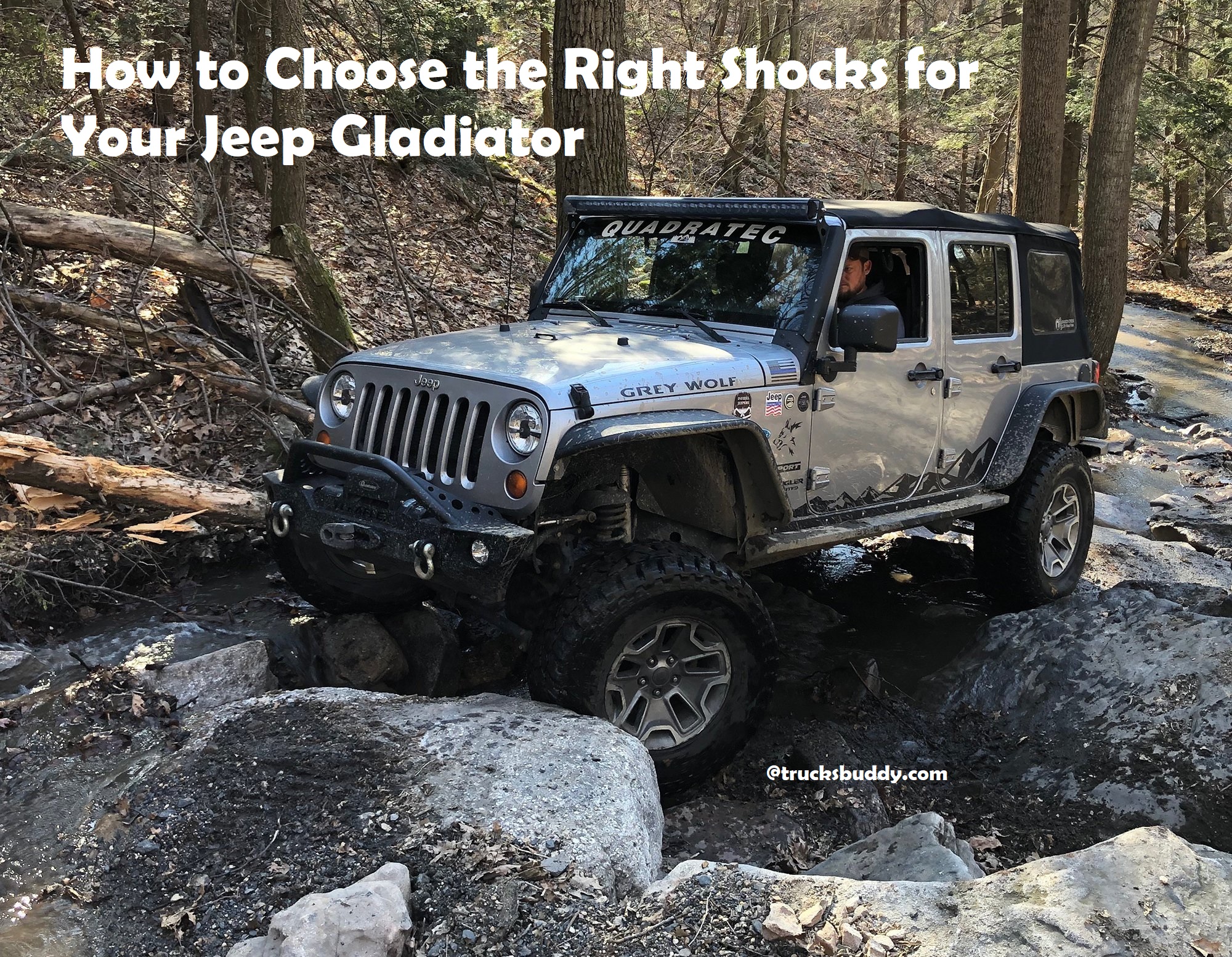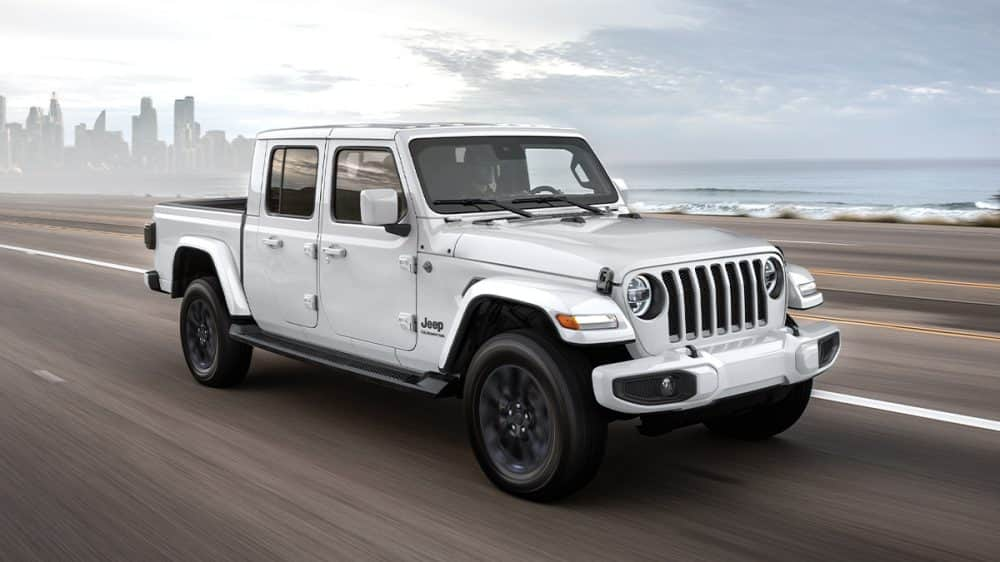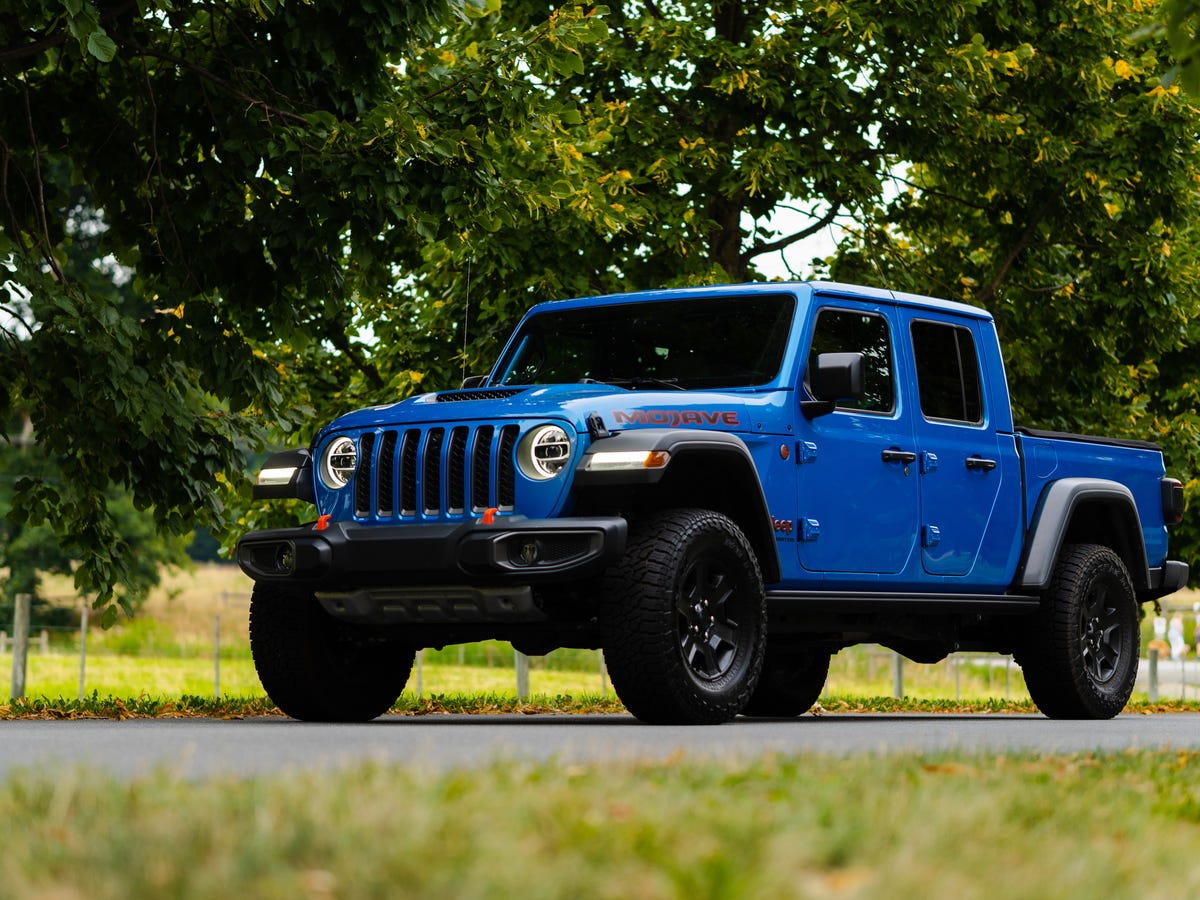Are you looking for improved off-roading performance and ride comfort for your Jeep Gladiator? You’ve come to the right place!
In this article, we’ll help you choose the best shocks for your Jeep Gladiator, so you can take your off-roading experience to the next level.
In this comprehensive guide, you’ll learn how to choose the right shocks for your Jeep Gladiator. Whether it’s a mild off-road adventure or an extreme rock-crawling excursion, obtaining the right shocks is key in keeping your Jeep stable and performing its best. This article will walk you through each type of shock available and help you decide which type would work best for your individual needs.
Next we will cover what exactly shocks do, what components they are made up of, as well as different types of shocks in detail to help ensure that by the end of this guide you have the knowledge necessary to pick up the correct equipment for your ride. Whether you’re taking it easy on the trails or mudding along those steep inclines, this article is here to provide a background and then let you make an educated decision about which shock system works best for you!
Factors to Consider When Choosing Shocks for Your Jeep Gladiator
When selecting the best shocks for your Jeep Gladiator, it is important to consider a few factors. The most important factor when selecting shocks will be the terrain and type of driving you expect to do with your Gladiator. Knowing the environment you plan to use your vehicle in will help you select the perfect shock for your Jeep Gladiator. The following are other factors you should consider when shopping for shocks:
– Suspension type: Different Jeeps have different suspension types and require shocks designed to fit those suspensions correctly. Utilizing the wrong shock absorber can cause harm or damage to both components and the ride quality.
– Shock valves: You should select a shock with valve settings to match your driving style and terrain usage. Shock valves control how quickly oil flows through them during compression/rebound cycles, thus controlling ride quality.
– Shock Mounts: While driving, suspension arms move up and down as wheels move off-road obstacles; so rock crawlers should look for better articulation which is offered by bump stop mounted shocks instead of axle mounts. Conversely, axle mount shock absorbers are more appropriate for highway driving and those who prefer firmer ride quality of their vehicle over articulation.
– Internal construction: Double tube internal construction offers more efficient cooling which helps keep temperatures down as well as extended service life from less wear on all parts inside the shock absorber bodies, like seals and bushings due to less extreme temperatures changes.
Terrain and Driving Conditions
When shopping for shocks for your Jeep Gladiator, it is important to consider the terrain and driving conditions you will encounter. If you are planning on doing a lot of off-roading, then you may want to invest in shocks designed specifically for off-road use. These shocks are designed to provide increased suspension articulation and better dampening control when driving over uneven terrain like rocks and logs.
For everyday on-road use it is best to choose a shock that provides superior handling, improved ride quality while seated in the Jeep, as well as improved braking performance. Look for features like adjustable dampening technology or twin-tube construction which can make all the difference when it comes to driving safety and comfort.
If you plan on doing extensive highway driving, then look for special load sensing mechanisms which help automatically adjust damping rates based on road conditions. This will ensure a smoother ride over long distances but still perform optimally when required during cornering or large bumpy surfaces.
Desired Ride Quality and Performance
The type of shocks you choose will significantly affect the ride quality and overall performance of your Jeep Gladiator. For example, off-road shocks typically provide greater stability in rough terrain and offer some additional adjustability for road conditions. Adjustable shocks allow the driver to select settings for various road conditions and terrain that helps to optimize the ride quality and dampen noise levels.
A suspension lift kit such as a coilover system increases ground clearance and also offers more precise control of the vehicle’s handling abilities. Other choices include air-assisted shocks, Bilstein shocks, or reservoir style shocks that can further enhance your driving experience. Ultimately, having an understanding of which components suit your individual needs is essential when choosing the best shock absorbers for your Jeep Gladiator.
Vehicle Weight and Payload
When choosing the right shocks for your Jeep Gladiator, vehicle weight and payload are key factors to consider. Lightweight vehicles may respond better to lighter weight shock absorbers, while heavier vehicles may require heavier models. Additionally, if you plan to be carrying loads in the bed of your truck or hauling a trailer, you should consider what the total weight of these items is before selecting shock absorbers that will support them.
You want to find a model that is capable of providing a comfortable ride even when under a heavy load.
III. How to Install Shocks on Your Jeep Gladiator
Installing shocks on a Jeep Gladiator is simple and straightforward. The first step is to familiarize yourself with all the parts that make up your Jeep Gladiator’s suspension system, including the shocks and related hardware. Once all the components are in place, installation follows a few basic steps:
- Lift the vehicle using a jack and support stands securely placed under the frame, then remove the old shocks from their mounts.
- Install spacers or washers (as directed), then begin fitting new shock absorbers at each mount position beginning with those furthest from you and work towards you for better access ability.
- Secure each shock absorber in its respective mount using supplied hardware or pre-existing mount bolts, and torque them to manufacturer specifications.
- Lower the vehicle to its original height by removing jacks and support stands while allowing all suspension components to settle into hade properly before tightening any further bolts or screws necessary for proper operation of your shocks and suspension system.
Tools Needed
Having the right tools on hand makes it easier and faster to install shocks. Make sure you have the following supplies before beginning the installation process:
– Properly sized sockets and wrenches; the sockets should fit snugly around the heads of all of your bolts.
– Flashlight or other bright light source; this is especially important if you’re working in a confined space or in low-light conditions.
– Jack stands or another suitable lifting device that can safely support your vehicle while you work on it.
– Torque wrench; since you’ll need to reattach many of the same bolts that were removed from your Jeep Gladiator, you want to be sure they are tightened properly for maximum safety and performance.
– Hammer and chisel; these tools can help loosen stubborn bolts when necessary.
Step-by-Step Guide
Installing the right shocks on your Jeep Gladiator can significantly enhance its driving performance and make off-roading experiences far more enjoyable. Having the correct set of shocks means that your suspension system will be better able to absorb bumps and dips in any terrain conditions. The following is a step-by-step guide for selecting and installing the perfect shock for your vehicle:
- Choose an appropriate shock – Select a shock based on the height and weight of your Jeep Gladiator, as well as other factors like road conditions, suspension geometry, etc. Research various brands to decide which one meets your specific needs.
- Measure – Use a measuring tape or other tool to ensure that you are selecting the appropriate size for your particular vehicle.
- Assemble – Gather all necessary tools such as wrenches, sockets, springs, etc., before beginning assembly of the shocks themselves. You should also consult any service manuals or instructions provided by the manufacturer or supplier to ensure proper installation technique is being followed.
- Install – Check that mounting holes are properly aligned before fastening bolts with a wrench or socket (always tightening according to manufacturer’s torque specs). Make sure all components are threaded properly and check all bushes for wear/tear before installing shocks onto their mounts. Finally, test by pressing down on each corner of jeep with hands (this will allow you to evaluate how evenly installed shocks are absorbing force).
Maintenance Tips for Jeep Gladiator Shocks
Maintaining your Jeep Gladiator shocks properly is essential to keep them in peak performance. To maintain your shocks, follow these tips:
- Clean and inspect the shocks regularly- Clean the shock absorbers with a damp cloth and examine them thoroughly for signs of wear and tear. Check for signs of damage and leaking. If you notice any problems, take your Jeep to a qualified technician for repair or replacement.
- Replace dust boots regularly- The dust boot is the seal located between the shock shaft and body that prevents dirt and moisture from entering the shock chamber. Dust boots should be replaced every 6 to 12 months depending on how often you drive or travel offroad with your Jeep Gladiator.
- Check for leaks – Shock absorbers may leak over time due to mechanical wear and tear, or extreme temperatures encountered during off roading adventures. If a shock absorber is leaking fluid, take it to a qualified technician immediately for repair or replacement; otherwise, damage could result from excessive fluid loss from leaking shocks.
- Check coilovers- Coilovers are adjustable suspension systems that replace most of the traditional components associated with a typical suspension system in order to get maximum adjustability on height, spring rate stiffness as well as corner weight balance when going offroad with your Jeep Gladiator Shock absorbers are often incorporated into such setups to provide additional suspension control when needed. Make sure that each coilover is functioning properly before each journey, as this will help ensure optimal performance on uneven terrain while driving offroad in your Jeep Gladiator.
Inspection
Before choosing the right shocks for your Gladiator, it is essential to inspect the existing condition of your vehicle’s shock absorbers. To begin with, open the hood of your jeep and take a look at the condition of the shock absorbers.
Examine for any visible signs of leaks around the shock mounting faces or on the body itself. Look for any irregularities in air pressure or damping performance by performing a few quick tests on each shock absorber (i.e. manually pressing down both sides of the vehicle’s body).
Check to see if there is anything unusual about the alignment, tightness and overall fitment of each shock absorber and mount points. If any anomalies are present, replace them at once with an appropriate and customised set of shocks that are designed specifically for use in your Gladiator model.
Cleaning
Cleaning the shocks is an often overlooked step in caring for your Jeep Gladiator. Cleaning is one of the most important steps in keeping your system running smoothly and efficiently.
Start by removing dirt and debris from the outside of the shocks by using a damp cloth or other appropriate cleaning materials. Be sure to remove all dirt and debris, as particles can damage the seals or interfere with proper functioning of the suspension system.
After thoroughly cleaning the exterior, use a lubricant such as WD-40 to lubricate any moving parts on the exterior, including ball joints and bushings. Additionally, depending on how you plan to use your vehicle, it’s important to ensure that everything is properly tightened after you have finished cleaning and lubricating. This can help prevent abnormal wear or breaking within the system over time.
Lubrication
When selecting shocks for your Jeep Gladiator, it is essential to consider the lubrication requirements needed for your shocks. The best shocks on the market have built-in self-lubricating properties that reduce friction, minimize wear and tear and optimize performance. If your shocks don’t have this feature, you will need to lubricate them on a regular basis in order to keep them running properly.
It’s also important to check all bolt, nut and washer for wear or damage when applying lubricant. In some cases, you may need to apply anti-seize compound if your OEM bolts are showing signs of corrosion or degradation. Additionally, you should regularly inspect the dust boot for debris or cracks and replace it if necessary—this helps ensure proper dust and water sealing protection.
Conclusion
When it comes to choosing the right shocks for your Jeep Gladiator, you need to take into account a number of different factors. To start, determine the terrain in which you plan to use your Gladiator and choose shocks that are appropriate for that type of terrain. Another factor to consider is whether or not you plan to make any upgrades or modifications to your Jeep. These modifications may necessitate additional or specialized suspension components, including shocks.
Lastly, decide on a budget for yourself and then research different shock manufacturers and models within that budget range.
By following these steps, you should be able to make an informed decision about the type of shocks best suited for your Jeep Gladiator. Additionally, knowing what questions to ask as you begin the selection process will further help ensure that you get the most out of your purchase and enjoy continued stability and comfort when driving your Gladiator!
FAQ’s
How do I choose the right shocks?
To choose the right shocks, you need to consider factors such as your vehicle’s weight, intended use, and budget.
How do you measure a Jeep for shocks?
To measure a Jeep for shocks, you need to measure the distance between the mounting points on the vehicle’s frame and axle.
Which shocks give the smoothest ride?
Generally, shocks with a softer compression rate and rebound will give a smoother ride, but the best option depends on your vehicle and intended use.
What are the different types of Jeep shocks?
The different types of Jeep shocks include twin-tube, monotube, remote reservoir, and coilover shocks.
What is the difference between 90 10 and 70 30 shocks?
90/10 shocks have a stiffer compression rate, allowing for better weight transfer during acceleration, while 70/30 shocks have a softer compression rate, providing better stability during braking.
What are Stage 2 shocks?
Stage 2 shocks are high-performance shocks designed for off-road vehicles that can handle rough terrain and provide better stability and control.
What is better V2 or N3 shocks?
The V2 shocks are designed for street use and provide a smoother ride, while the N3 shocks are designed for off-road use and provide better off-road performance.
Are aftermarket shocks better?
Aftermarket shocks can be better than stock shocks in terms of performance, durability, and adjustability, but the best option depends on your vehicle and intended use.
Are softer shocks better?
Softer shocks can provide a smoother ride, but they may not be the best option for all vehicles and driving conditions.
What is the lifespan of shocks?
The lifespan of shocks can vary depending on factors such as vehicle use and driving conditions, but most shocks should be replaced every 50,000 to 100,000 miles.
See Also-
- Best tires for jeep gladiator
- Best brush guard for jeep gladiator
- Best brake pads for jeep gladiator
- Best tuner for jeep gladiator
- Best replacement antenna for jeep gladiator

